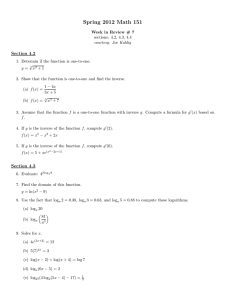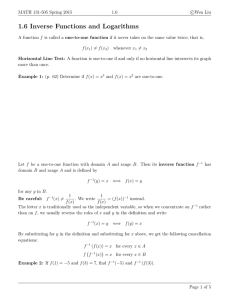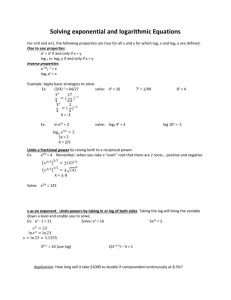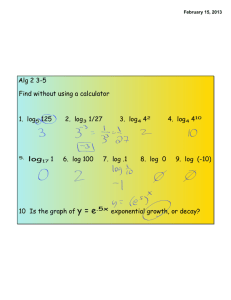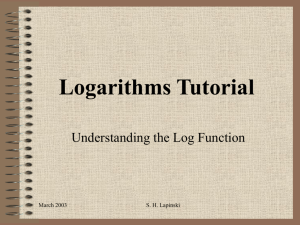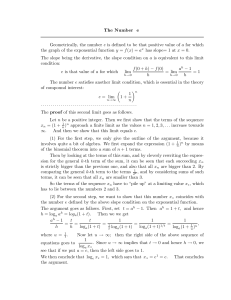Document 10434885
advertisement
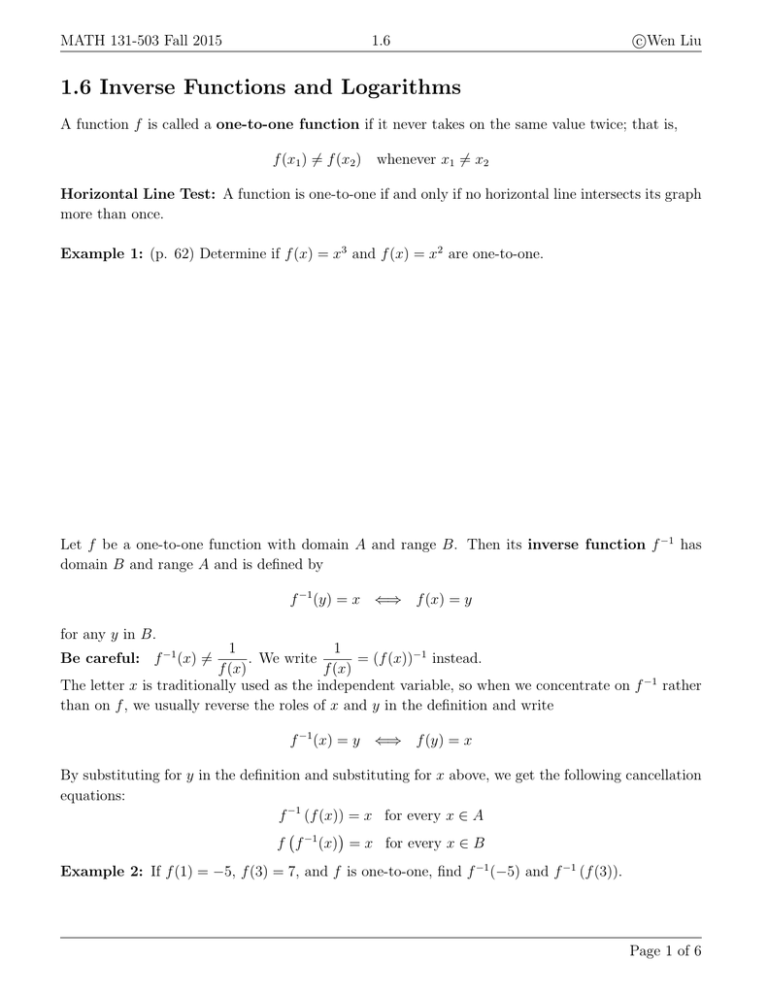
MATH 131-503 Fall 2015 1.6 c Wen Liu 1.6 Inverse Functions and Logarithms A function f is called a one-to-one function if it never takes on the same value twice; that is, f (x1 ) 6= f (x2 ) whenever x1 6= x2 Horizontal Line Test: A function is one-to-one if and only if no horizontal line intersects its graph more than once. Example 1: (p. 62) Determine if f (x) = x3 and f (x) = x2 are one-to-one. Let f be a one-to-one function with domain A and range B. Then its inverse function f −1 has domain B and range A and is defined by f −1 (y) = x ⇐⇒ f (x) = y for any y in B. 1 1 . We write = (f (x))−1 instead. f (x) f (x) The letter x is traditionally used as the independent variable, so when we concentrate on f −1 rather than on f , we usually reverse the roles of x and y in the definition and write Be careful: f −1 (x) 6= f −1 (x) = y ⇐⇒ f (y) = x By substituting for y in the definition and substituting for x above, we get the following cancellation equations: f −1 (f (x)) = x for every x ∈ A f f −1 (x) = x for every x ∈ B Example 2: If f (1) = −5, f (3) = 7, and f is one-to-one, find f −1 (−5) and f −1 (f (3)). Page 1 of 6 MATH 131-503 Fall 2015 1.6 c Wen Liu How to Find the Inverse Function of a One-to-One Funtion f : 1 Write y = f (x) 2 Solve this equation for x in terms of y (if possible) 3 To express f −1 as a function of x, interchange x and y. The resulting equation is y = f −1 (x). Examples: 3. Given f (x) = x2 + 9. (a) Is the function one-to-one? If not, restrict the domain so that the function is one-to-one. (b) State the domain and range for the function. (c) Find f −1 (x). (d) State the domain and range for f −1 (x). Page 2 of 6 MATH 131-503 Fall 2015 4. Find the inverse of f (x) = 1.6 c Wen Liu 6x − 1 . 2x + 5 Note: The graph of f −1 is obtained by reflecting the graph of f about the line y = x. Example 6: (p. 64) Sketch the graphs of f (x) = coordinate axes. √ −1 − x and its inverse function using the same Page 3 of 6 MATH 131-503 Fall 2015 1.6 c Wen Liu Logarithmic Functions If a > 0 and a 6= 1, the exponential function f (x) = ax is either increasing or decreasing and so it is one-to-one by the Horizontal Line Test. It therefore has an inverse function f −1 , which is called the logarithmic function with base a and is denoted by loga . If we use the formulation of an inverse function given above, we have loga x = y ⇐⇒ ay = x Note: loga (ax ) = x for every x ∈ R aloga x = x for every x > 0 Laws of Logarithms: If x and y are positive numbers, then 1. loga (xy) = loga x + loga y x 2. loga = loga x − loga y y 3. loga (xr ) = r loga x, where r is any real number Example 7: Find the exact value of log2 6 − log2 15 + log2 20. Natural Logarithms The logarithm with base e is called the natural logarithm and has a special notation: loge x = ln x Then we have ln x = y ⇐⇒ ey = x ln(ex ) = x x ∈ R eln x = x x > 0 ln e = 1 Page 4 of 6 MATH 131-503 Fall 2015 1.6 c Wen Liu Examples: 8. Express the given quantity as a single logarithm. ln(a + b)2 + ln(a − b) − 5 ln c. 9. Solve each equation for x. (a) e9x+a − 9 = 0 for some constant a. (b) ln(2 − 6x) + m = 0 for some constant m. Page 5 of 6 MATH 131-503 Fall 2015 10. Find (a) the domain of f (x) = c Wen Liu 1.6 √ 3 − e2x and (b)f −1 and its domain. Change of Base Formula: For any positive number a (a 6= 1), we have loga x = ln x ln a Example 11: (p. 87) Evaluate log8 5 correct to six decimal places. Page 6 of 6
